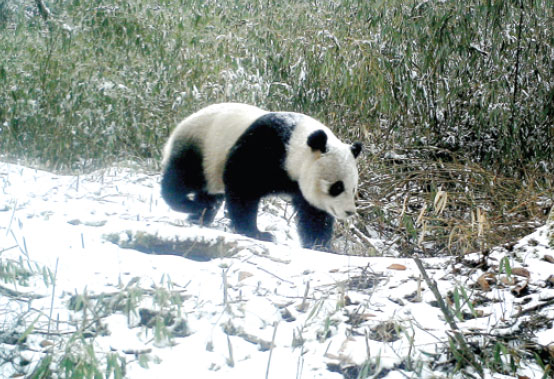

A photo of a panda taken in 2011 by an infrared camera in the Anzihe Nature Reserve, Sichuan province. Provided to China Daily
Technology aids in keeping watchful eye on poachers
Visitors to the Anzihe Nature Reserve in Sichuan province can't help but notice the stunning photos on display at its publicity and education center.
One shows a baby panda following its mother on the ridge of a mountain; another is an awe-inspiring shot of a snow leopard.
All of the shots were taken by infrared cameras.
"The cameras, donated by domestic and international organizations, have allowed images to be taken of endangered animals which normally people can never hope to see for themselves," said Wang Lei, deputy director of the reserve's management office.
The cameras are also used to help detect poachers and herbal medicine collectors, Wang said.
Based in Chongzhou, Anzihe is one of China's major panda conservation reserves.
It is connecting to another two panda reserves in the province - Wolong National Nature Reserve in Wenchuan and Heishuihe Nature Reserve in Dayi. It is a passageway that pandas use to find partners during the mating season.
"Pandas live alone but can travel to the other reserves to find partners. The passageway is important to prevent in-breeding," said Zhang Hemin, chief of Wolong's administrative bureau.
According to the third national panda census conducted during 1999 and 2000, Anzihe was home to around 10 wild pandas. A fourth census has just been completed with data yet to be released. But the reserve, set up in 1993, has just 10 full-time employees and is short of funds.
Employees are only able to patrol in the mountains once a year and many have never actually seen a panda with their own eyes, given how pandas studiously avoid any contact with people.
But the staff can now study the wild pandas in photos and on video to better understand their habits, thanks to the donated infrared cameras. Anzihe first started monitoring pandas and other endangered animals using five donated infrared cameras back in 2007 as part of a joint project by Peking University and Washington Zoo in the United States.
"The film and the batteries ran out very quickly, and so we didn't manage to capture many of the animals. But we quickly learned how to use them better," said Fu Qiang, the technician in charge of the cameras at the reserve.
In 2008, a magnitude-8 earthquake devastated many parts of Wenchuan, leaving nearly 90,000 people dead or missing, and Anzihe was hit hard.
But thanks to the Shanshui Conservation Center, a bio-diversity organization founded by Lu Zhi, a professor at the Peking University, the reserve still received five new infrared cameras that year.
"The cameras showed that many of our endangered species, including the pandas, survived the quake," Fu said.
Between 2012 and 2014, the World Wide Fund for Nature donated another 15 cameras to Anzihe, meaning far more protected animals could be monitored and photographed. As well as pandas, images of snow leopards, snub-nosed monkeys, wildebeests, forest musk deer, Chinese monal pheasants, Chinese grouse and chestnut-throated partridges were captured.
"Thanks to the photos and videos we took we were able to get a far better idea of the numbers of animals we have on the reserve," Fu said.
"Before the infrared cameras took photos of the snub-nosed monkey, for instance, people in Anzihe had never seen it for more than a decade and thought it had been driven out by the much-larger Tibetan macaque."
As well as raising public awareness, the network of cameras has helped catch poachers or stop those attempting to steal endangered herbal medicines.
"After the cameras took photos of poachers carrying guns, and illegal herb collectors with bags on their backs full of plants, employees were able to identify them and either warn them off or educate them," said Zheng Xiaolin, a resident of Jiguanshan township where the reserve is located. "We have not heard of anyone poaching since."
World Animal Protection, an international non-profit animal welfare organization, donated another 30 infrared cameras to Anzihe earlier this month.
Funding has come in from a huge variety of organizations, including banking giant HSBC Plc, the world's largest courier company Fed-Ex Express, and the US gums and candy producer, Wrigley, said Yang Biao, an official with Conservation International, which donated five cameras and a camcorder to Anzihe in 2009.
Copyright ©1999-2018
Chinanews.com. All rights reserved.
Reproduction in whole or in part without permission is prohibited.